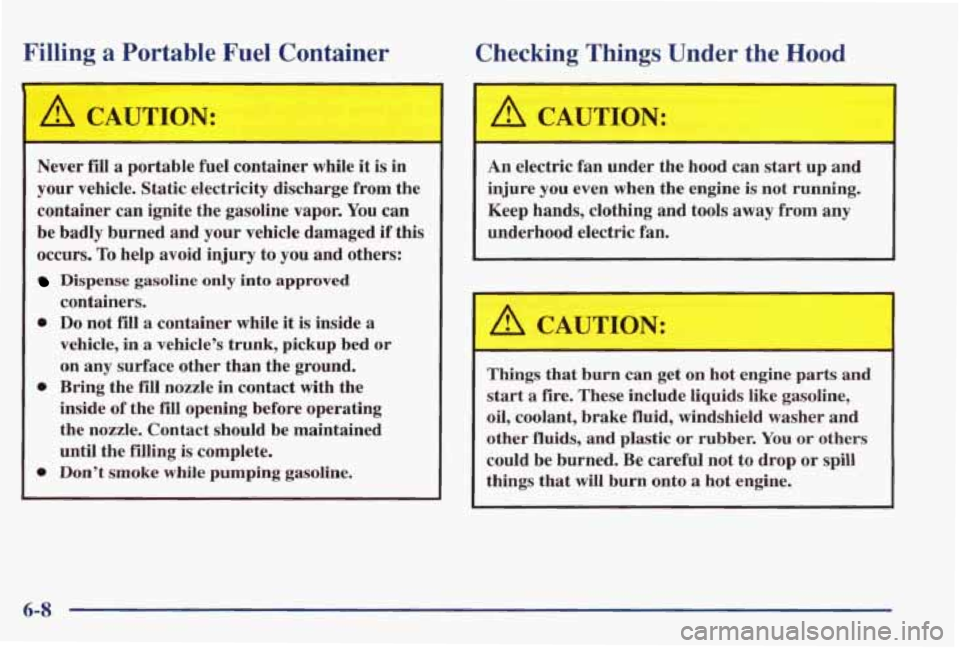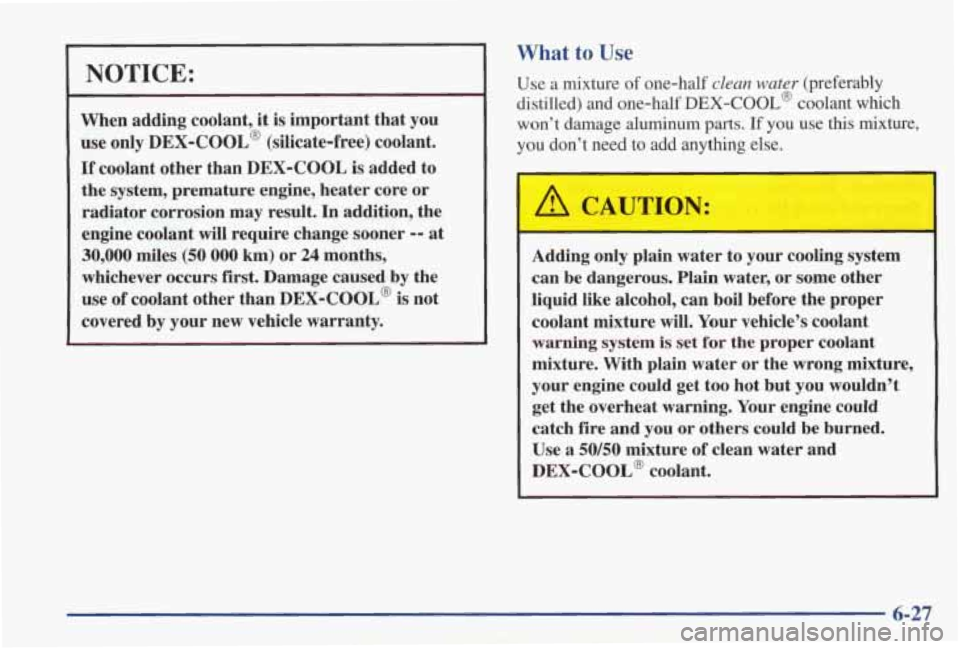Page 283 of 402

Filling a Portable Fuel Container
A CAUTION:
Never fill a portable fuel container while it is in
your vehicle. Static electricity discharge from the
container can ignite the gasoline vapor. You can
be badly burned and your vehicle damaged
if this
occurs.
To help avoid injury to you and others:
Dispense gasoline only into approved
containers.
0 Do not fill a container while it is inside a
vehicle, in a vehicle’s trunk, pickup bed
or
on any surface other than the ground.
0 Bring the fill nozzle in contact with the
1 inside of the fill opening before operating
the nozzle. Contact should be maintained
1 until the filling is complete.
~ 0 Don’t smoke while pumping gasoline.
i
Checking Things Under the Hood
A CAUTION: I
An electric fan under the hood can start up and
injure you even when the engine
is not running.
Keep hands, clothing and tools away from any
underhood electric fan.
Things that burn can get on hot engine parts and
start a fire. These include liquids like gasoline,
1 oil, coolant, brake fluid, windshield washer and
other fluids, and plastic
or rubber. You or others
could be burned. Be careful not to drop or
spill
things that will burn onto a hot engine.
6-8
Page 285 of 402
When you open the hood of the 3100 engine, you'll see:
n
A. Windshield Washer Fluid
B. Battery
C. Radiator Fill Cap
D. Power Steering
Fluid Reservoir
E. Engine Oil Fill Cap
E Engine Oil Dipstick G.
Automatic Transaxle Dipstick
H. Brake Fluid Reservoir
I. Engine Coolant Reservoir
J. Air Cleaner
6-10
Page 286 of 402
When you open the hood of the 3800 engine, you’ll see:
A. Windshield Washer Fluid
D. Power Steering G. Automatic Transaxle Dipstick
B. Battery Fluid Reservoir
H. Brake Fluid Reservoir
C.
Radiator Fill Cap E. Engine Oil Dipstick I. Engine Coolant Reservoir
E Engine Oil Fill
Cap J. Air Cleaner
6-11
Page 287 of 402
When you open the hood of the 3800 Supercharged engine, you'll see:
D. Power Steering
Fluid Reservoir
E. Engine Oil Dipstick
F. Engine Oil Fill Cap
G. Automatic Transaxle Dipstick
H. Brake Fluid Reservoir
I. Engine Coolant Reservoir
J. Air Cleaner
A. Windshield Washer Fluid
B. Battery
C. Radiator Fill Cap
6-12
Page 301 of 402

How to Add Fluid
Refer to the Maintenance Schedule to determine what
kind of transaxle fluid to use. See “Recommended
Fluids and Lubricants” in the Index.
If the fluid level is low, add only enough of the proper
fluid to bring the level into the cross-hatched area on
the dipstick.
1. Pull out the dipstick.
2. Using a long-neck funnel, add enough fluid at the
dipstick hole to bring it to the proper level.
It doesn’t take much fluid, generally less
than one
pint
(0.5 L). Don’t ovefill.
LOTICE:
We recommend you use only fluid labeled
DEXRON@-111, because fluid with that label
is
made especially for your automatic transaxle.
Damage caused
by fluid other than DEXRON-III
is not covered by your new vehicle warranty.
3. After adding fluid, recheck the fluid level as described
4. When the correct fluid level is obtained, push the
under “How to Check” earlier in this section.
dipstick back in
all the way.
Engine Coolant
The cooling s stem in your vehicle is filled with
DEX-COOL engine coolant. This coolant is designed
to remain
in your vehicle for 5 years or 150,000 miles
(240 000 km) whichever occurs first, if you add only
DEX-COOL’ extended life coolant.
The following explains your cooling system and how to
add coolant when it is low. If you have a problem with
engine overheating
or if you need to add coolant to your
radiator, see “Engine Overheating” in the Index.
A 50/50 mixture of water and DEX-COOL’
coolant will:
0 Give freezing protection down to -34°F (-37°C).
Give boiling protection up to 265 OF (129°C).
J
e Protect against rust and corrosion.
e Help keep the proper engine temperature.
0 Let the warning lights and gages work as
they should.
6-26
Page 302 of 402

NOTICE:
When adding coolant, it is important that you
use only
DEX-COOL’ (silicate-free) coolant.
If coolant other than DEX-COOL is added to
the system, premature engine, heater core or
radiator corrosion may result. In addition, the
engine coolant will require change sooner
-- at
30,000 miles (50 000 km) or 24 months,
whichever occurs
first. Damage caused by the
use of coolant other than DEX-COOL@ is not
covered by your new vehicle warranty.
What to Use
Use a mixture of one-half clean water (preferably
distilled) and one-half
DEX-COOL’ coolant which
won’t damage aluminum parts. If you use this mixture,
you don’t need
to add anything else.
L
I
A CAUTIONI
I
Adding only plain water to your cooling system
can be dangerous. Plain water, or some other
liquid like alcohol, can boil before the proper
coolant mixture will. Your vehicle’s coolant
warning system
is set for the proper coolant
mixture. With plain water or the wrong mixture,
your engine could get too hot but you wouldn’t
get the overheat warning. Your engine could
catch fire and you or others could be burned.
Use a
50150 mixture of clean water and
DEX-COOL@ coolant.
6-27
Page 303 of 402
NOTICE:
If you use an improper coolant mixture, your
engine could overheat and be badly damaged.
The repair cost wouldn’t be covered by your
warranty. Too much water in the mixture can
freeze and crack the engine, radiator, heater core
and other parts.
If you have to add coolant more than four times a year,
have your dealer check your cooling system.
NOTICE:
If you use the proper coolant, you don’t have to
add extra inhibitors or additives which claim to
improve the system. These can be harmful.
Checking Coolant
i
When your engine is cold, the coolant level should be
at the COLD mark or a little higher. When your engine
is
warm, the level should be up to the HOT mark or a
little higher.
6-28
Page 304 of 402
If this comes on, it
LOW
COOLANT
means you’re low on
engine coolant.
Adding Coolant If
you need more coolant, add the proper DEX-COOL@
coolant mixture at the coolant recovery tank, but be
careful not to spill it.
A CAUTION:
lbrning the radiator pressure cap when the
engine and radiator are hot can allow
steam and
scalding liquids to blow out and burn you badly.
With the coolant recovery tank, you will almost
never have to add coolant at the radiator.
Never turn the radiator pressure cap
-- even a
little -- when the engine and radiator are hot.
If the coolant recovery tank is completely empty, add +
coolant to the radiator. (See “Engine Overheating’’ in \
the Index.)
’ /1 CAUTION:
You can be burned if you spill coolant on hot
engine parts. Coolant contains ethylene glycol,
and it will burn if the engine parts are hot
enough. Don’t spill coolant on a hot engine.
6-29